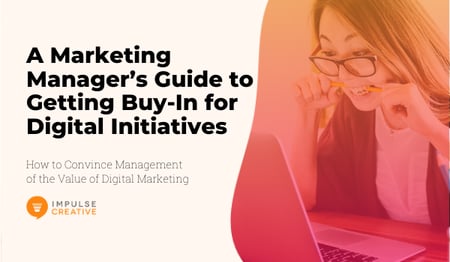Are you a frustrated marketing manager at a company where your management team holds back on digital marketing?
Do any of these situations feel familiar?
 Management isn’t fully supportive of a digital-first mindset
Management isn’t fully supportive of a digital-first mindset- Your sales department resists change and new methodologies
- Your sales team colleagues don’t know what the marketing team is doing
- Only one person in the company knows about the content you’re producing
- Your company’s sales team doesn’t contribute to content topics (they’re the ones answering customers’ and prospects’ questions)
- Marketing produces content but the sales team doesn’t use it
- The CEO, CMO, CFO can’t define inbound marketing with confidence
- The executive team doesn’t really understand how Google works
Stakeholders— leadership, investors, employees/colleagues, customers and suppliers affected by the business— may not buy into the idea of digital marketing. Content, inbound, demand gen, ABM… the marketing landscape is evolving. Not everyone can keep up.
Why Stakeholders May Not Support Digital Marketing
While there are many individual reasons for a lack of buy in from different stakeholders, we hear a few broad categories from our clients:
- Management doesn’t believe there’s a need to change long-standing practices. They’ve always done it a specific way and it works well enough. “Our clients are different” or “We’ve never gotten a client from our website.” Because their personal experience doesn’t include success with modern marketing strategies and tactics, stakeholders reject the need to do anything differently.
- They don’t believe that marketing can make a difference; there’s a lack of confidence that marketing can actually improve growth or profitability. They probably fear spending money and time only to have nothing change.
- They’re afraid that marketing will ask them to do something they’re uncomfortable with or can’t do. Fear of change is certainly a part of it, but there is more: “What if someone asks a question that I don’t know how to answer? What if I look unprofessional or silly?”
There’s a lot of fear driving the resistance. There’s also a bad taste from bad marketing and even misinformation about modern marketing.
Our current situation of difficulty getting buy-in from leadership for digital marketing initiatives shouldn’t surprise us. But it shouldn’t discourage us, either.
If you’re responsible for marketing success, what can you do to generate the buy-in you need to do your job?
Building the Case for Digital Initiatives
How do you get your bosses to buy into digital initiatives as a marketing manager?
Speak their language. Show how digital marketing will impact revenue. Prove profitability. Bring data plus story for a powerful connection to leadership.
Let’s look at where to start.
1. Build the Linkage Between Marketing and Business Strategy
This first means boiling your business strategy down into its core elements so marketing understands them.
What is your business tasked with delivering? If it’s about growth, then how is that going to be achieved?
What is the role of digital? Is it about acquiring more customers? Or is it about getting your existing customers to spend more? If it’s about customers spending more, is that through increasing frequency of purchase or increasing average purchase vale?
The answers to these questions will shape the nature of your investment and capabilities. If there is no formal strategy for these things, then you are just about to write one.
2. Translate Business Outcomes into a Desired Customer Outcome
Assuming you want to achieve this growth, what’s going to happen differently for customers to make this happen?
This is the critical difference between a cost and risk avoidance approach. Are you going to reach a newer, larger audience, or is it about improving the experience for your existing customers? Are you going to have more targeted offers? Or is it about increasing conversion through personalisation?
Having a clear plan of how you’ll deliver business value establishes the basis for your capability roadmap with digital marketing.
At this point you haven’t asked for any money - you’ve set out the stall that describes what the prize is for the business. Next comes the roadmap which describes what the business needs to do to reach it.
3. Map Your Desired Business Outcomes on a Digital Marketing Roadmap
This is where you start describing your roadmap to success. The roadmap identifies the business capabilities that are required to deliver the customer outcomes you described in step two.
Business capabilities include technology, but that’s not all that should be included. Capabilities also include the data, people, skills and business processes required to make your customer outcomes a reality.
This roadmap should describe what your business needs to be able to do, and in what order, over the next two-to-three years to achieve the customer outcomes you have described. It also feeds into your business case and describes how the outcomes are supported by the investment required.
4. Be Clear on How You’ll Measure Success
Now that you’ve outlined your vision for delivering on the business strategy, you can see what this will mean for customers and what the business needs to do to make that happen.
There’s one more thing to consider: When you’re implementing a multi-year roadmap, it’s going to span multiple quarters and their budget cycles.
Given that the rewards for your work only start appearing after the work is done, you need to give your stakeholders confidence that you’re making progress against them. If they lose confidence in your progress, you run the risk of failing to jump the hurdle of the next budget cycle.
It’s time for a success measurement framework. You’ll measure the leading indicators for success.
For this, it’s useful to look at multiple dimensions across a balanced scorecard for success. Not only do you want to measure critical customer outcomes such as more traffic, improving engagement or greater conversion, but also operational outcomes that lead to success.
This could be improvements in efficiency or speed of getting content, offers and campaigns to market, as well as demonstrating that you’re continually improving skills, refining your methods of attracting and retaining the right talent. If you aren’t able to measure this, you won’t be able to manage it and you won’t be able to argue your case for funding at budget time.
Build the Buy-In Presentation
The best way to go about making the ask for digital marketing buy-in is through a data-driven, story-laden, engaging presentation. Make sure the leadership behind your brand understands the value of a powerful modern marketing strategy as much as you do by outlining it for them in a way they’ll understand and that is impactful to their perspective.
Want to boost the power of your presentation?
- Be clear about what you’re asking for. // Don’t wait until the end of your presentation to discuss what you’re after. Instead, be clear about your plan and needs upfront, then use the rest of your presentation to explain why it’s the best choice for the company’s brand.
- Explain what’s currently being done. // Lay out exactly how your marketing is currently being done and include where there is room for improvement. Be sure to include areas where you feel incorporating content marketing would be most beneficial.
- Outline the benefits. // You know the benefits to digital marketing. From efficiency to engagement, digital helps brands large and small grow. In your presentation, avoid rattling off a list of generic benefits. Instead, discuss the individual ways that digital will benefit your brand. More specifically, how will it benefit your presentation audience directly?
- Prove your claims. // Don’t just tell them, show them. Use case studies and reports that closely relate to the digital marketing strategy you plan to implement in your organization to prove that it works.
- Outline your plan of attack. // Now that you’ve got them all fired up, present your plan. Detail your powerful digital marketing strategy that will take your organization to the next level.
- Ask. // Make a clear ask for exactly what you want in a clear and concise manner. Don’t forget to make it easy for them to take action right away. You want your presentation’s momentum to take you as far as it can, so have the avenues in place to get the ball rolling as soon as you get the approval.
Bonus “Hack” for Getting Digital Buy-In
Get an outside expert to educate stakeholders.
No matter how right you are or how well-researched your recommendations, there are inherent limits to your influence. You may be too familiar to your long-time colleagues, so it’s easy for them to take you for granted. Or in the eyes of your colleagues, you may be “too new” or “too young” to understand your clients.
“You are never a prophet in your own land.” Sad, but true.
So what is the solution? Bring in an outside expert to educate and inform your stakeholders. Make it someone they’ll respect and trust. An outside expert’s observations and recommendations will often carry more weight than the very same points coming from you.
If you’re a marketer struggling to get funding for digital techniques, take a breath, You’re not alone. A lot of marketing managers just like you are working to get their companies to lean into digital marketing.
You can start with a resource we put together to help you lean into a digital strategy. And if you need an empathetic ear, let us know.





